The family Asteraceae is one of our largest plant families and species with yellow 'dandelion/daisy' type flowers make up a significant proportion of that family. So often, these plants all get lumped under the heading of 'dandelions', but there are many species, some of which are infuriatingly similar, so care must be taken in identifying them accurately. For ease, the descriptions here talk about 'flowers' but in this family, what appears to be a single flower is actually a cluster of several to many flowers - often refered to as florets - with the inner florets often being petalless, while those around the outside bear the petals - the whole appearing to form a single flower. As you work through the choices on this page, the structure of these compound flowers will be important, as well as the overall size and growth style of the plant - most notably, whether the flowers are carried on upright, branching stems, or whether there is a basal rosette of leaves with the flowers arising from that. As this is such a large group, this page will help narrow your search, once you have arrived here from the flower colour pages.
The main purpose of this page is to attempt to break this family up into bite-sized chunks, so that the pages you are led to do not get too big by containing a large number of species. At worst, if you follow a link from here and do not see your plant, return to this page and try another link. Note that some species may come in a variety of flower colours; in such cases, the species is shown on more than one page, so you should still find it.
At this stage, be sure to read the texts below carefully, as they contain identification information that may not be visible in the photographs; clicking to the next stage will help you get to the exact species. It is important with this family to not only look at flower colour but also to look at detail of the green outer part of the flower head, which is made up of overlapping segments called phyllaries. It is also helpful to note details of both basal and stem leaves.
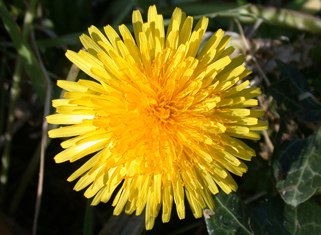 |
Dandelions, Cat's-ears, Hawkbits & other low species
True dandelions and their close allies (Cat's-ears, Hawkbits, Mouse-ear Hawkweeds etc.) have flowerheads made up of florets all of the same type, the florets in the middle simply having shorter petals than those around the outside. In this group, the leaves all appear as a basal rosette, held close to the ground, while the flowers rise above these, usually one flowerhead to a stem, though in the cat's-ears, these stems are usually forked - but still leafless. Low species, typically less than 25cm in height. |
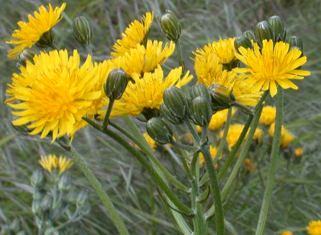 |
Hawkweeds, Hawk's-beards & other tall species
These species are rather similar to the true dandelions but differ in being much taller plants, 30-100cm in height. The flowerheads are made up of florets all of the same type, the florets in the middle simply having shorter petals than those around the outside. In this group, the leaves first appear as a basal rosette, held close to the ground, but then there are also leaves along the stems - and these leaves may differ slightly from the basal ones. Typically, the flowers are a smaller than those of dandelions, but are more numerous on the plant and are often carried in many-branched heads. |
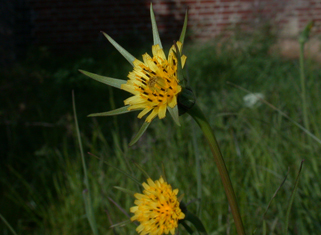 |
Goat's-beards
The flowerheads are made up of florets all of the same type, the florets in the middle simply having shorter petals than those around the outside. What makes this group distinctive is the very long, green phyllaries, that spread out, star-like from the base of the flowerhead. In this group, the leaves are long and narrow, untoothed and almost grass-like, but clasp the stem at the base and have a silvery line down the centre. |
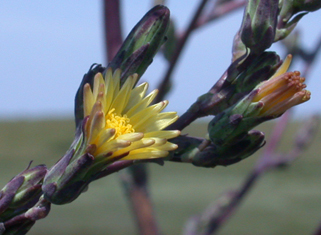 |
Lettuces, Sow-thistles & Allies
The flowerheads in this group are made up of florets all of the same type, the florets in the middle simply having shorter petals than those around the outside. They closely resemble dandelion flowers, but each compound flower is much smaller than those of dandelions and the flowers are carried many at a time on much-branched stems. Basal leaves and stem leaves tend to be rather similar to each other, though the leaves generally get smaller towards the top of the stems; leaves often have soft spines along the midrib on the underside. Plants are usually at least 50cm tall and sometimes reach two metres or more in height! |
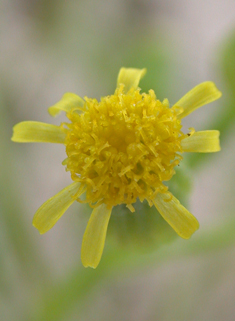 |
Groundsels
Unlike the dandelion groups above, the flowerheads of this group have florets of two kinds. The outer florets have obvious, strap-like petals called ligules, which form a ring around the outside, while the inner florets appear petalless and form a yellow 'button' centre. In this group, the outer petals are narrow and not overlapping (those of the marigold groups below tend to be broader and more obviosuly overlapping). These are rather small, usually much branched, annuals of disturbed ground. |
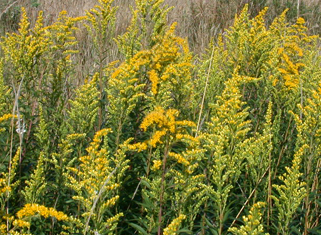 |
Goldenrods
In this group, the individual clusters of florets are rather small, but clustered together into elongate, usually many-branched, flowerheads. The flowerheads are clustered along the branches to form upright or spreading spikes and many of the plants spread vegetatively to form colonies of stems. |
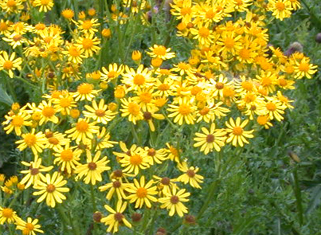 |
Ragworts, Fleabanes & Allies
The flowerheads of this group have florets of two kinds. The outer florets have obvious petals which form a ring around the outside, while the inner florets appear petalless and form a yellow 'button' centre in the style of a daisy flowerhead. In this group, the outer petals are rather narrow and often not overlapping (those of the marigold groups below tend to be broader and more obviosuly overlapping). These plants are rather variable in appearance but unlike the following group, they tend to be many-branched and often form rather bushy stands of vegetation, with the stems becoming tough and woody towards the base by the end of the year and often persisting over winter. The leaves may be simple or complexly lobed. |
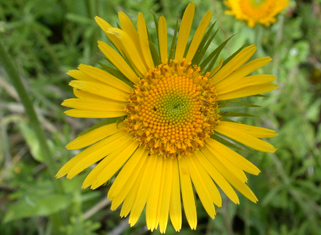 |
Colt's-foot, Leopard's-banes & Similar Species
Unlike the dandelion groups above, the flowerheads of this group have florets of two kinds. The outer florets have obvious petals which form a ring around the outside, while the inner florets appear petalless and form a yellow 'button' centre in the style of a daisy flowerhead. In this group, the outer petals are narrow and usually very numerous and not easily counted. These plants are very variable in appearance but unlike the ragowrt group, they tend to have simple, not branched stems and are herbaceous, dying down in the winter and so having no woody parts in the summer. The leaves are typically simple, often toothed or lobed at the margins. |
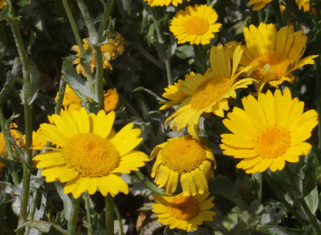 |
Yellow Marigolds, Yellow Chamomiles & Allies
The flowerheads of this group have florets of two kinds. The outer florets have obvious petals which form a ring around the outside, while the inner florets appear petalless and form a yellow 'button' centre in the style of a daisy flowerhead. The flowerheads are typically relatively large and carried one to three on the stems, not in many-branched heads. In this group, the outer petals are rather broad and usually overlapping (those of the ragwort and fleabane group above tend to be narrower and often barely overlapping). These plants are rather variable in appearance but they tend to be many-branched and often form rather bushy stands of vegetation. The leaves may be simple or complexly lobed. (Some flowers may be predominantly yellow, but with other colours also present.) |
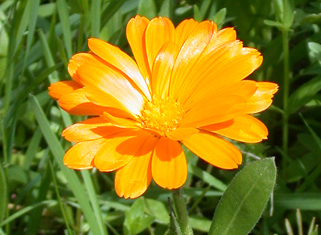 |
Orange Marigolds, Gazanias & Allies
The flowerheads of this group have florets of two kinds. The outer florets have obvious petals which form a ring around the outside, while the inner florets appear petalless and form a 'button' centre in the style of a daisy flowerhead. The flowerheads are typically relatively large and carried one to three on the stems, not in many-branched heads; they may be all orange, or a mixture of shades of orange or yellow. These plants are rather variable in appearance but they tend to be many-branched and often form rather bushy stands of vegetation. The leaves may be simple, toothed or lobed. (Some flowers may be predominantly yellow, but with other colours also present.) |
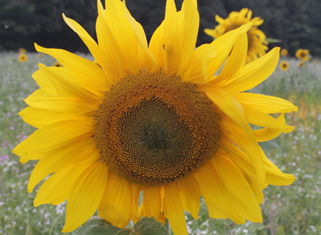 |
Sunflowers
The huge, showy flowers of sunflowers are well-known, with their outer rim of yellow petals and inner 'button' of yellowish or brownish florets. Some close relatives are similar but have much smaller flowers, which nevertheless show a similar appearance to the flowers. Leaves are typically simple, not lobed or compound and plants are usually relatively tall - from 50cm to two metres in height. |
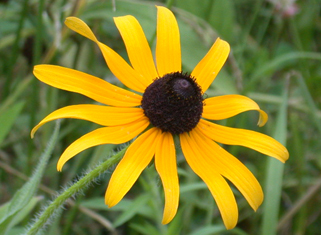 |
Coneflowers
Plants in this group are rather similar to the sunflowers, the flowerheads having prominent yellow petals around the outside and a button centre. In this group of plants, the centre is usually brown and clearly a different colour to the petals. |
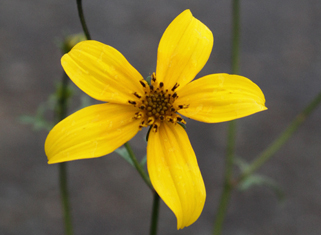 |
Beggarticks & Allies
These plants are recognisable as members of the daisy family (Asteraceae) by virtue of their compound flowerheads having prominent-petalled florets around the outside and a button centre made up of many petalless florets. However, they vary in having less than 10 (often five) strap-like petals, rather than the numerous array that is typical of other members of the family. They could be confused at first with other five-petalled, yellow flowers, but a closer look will reveal their true structure with numerous, individual florets. |